-
CATEGORY ::
- All Seeds /
- All Flower Seeds /
- All Zinnia Seeds





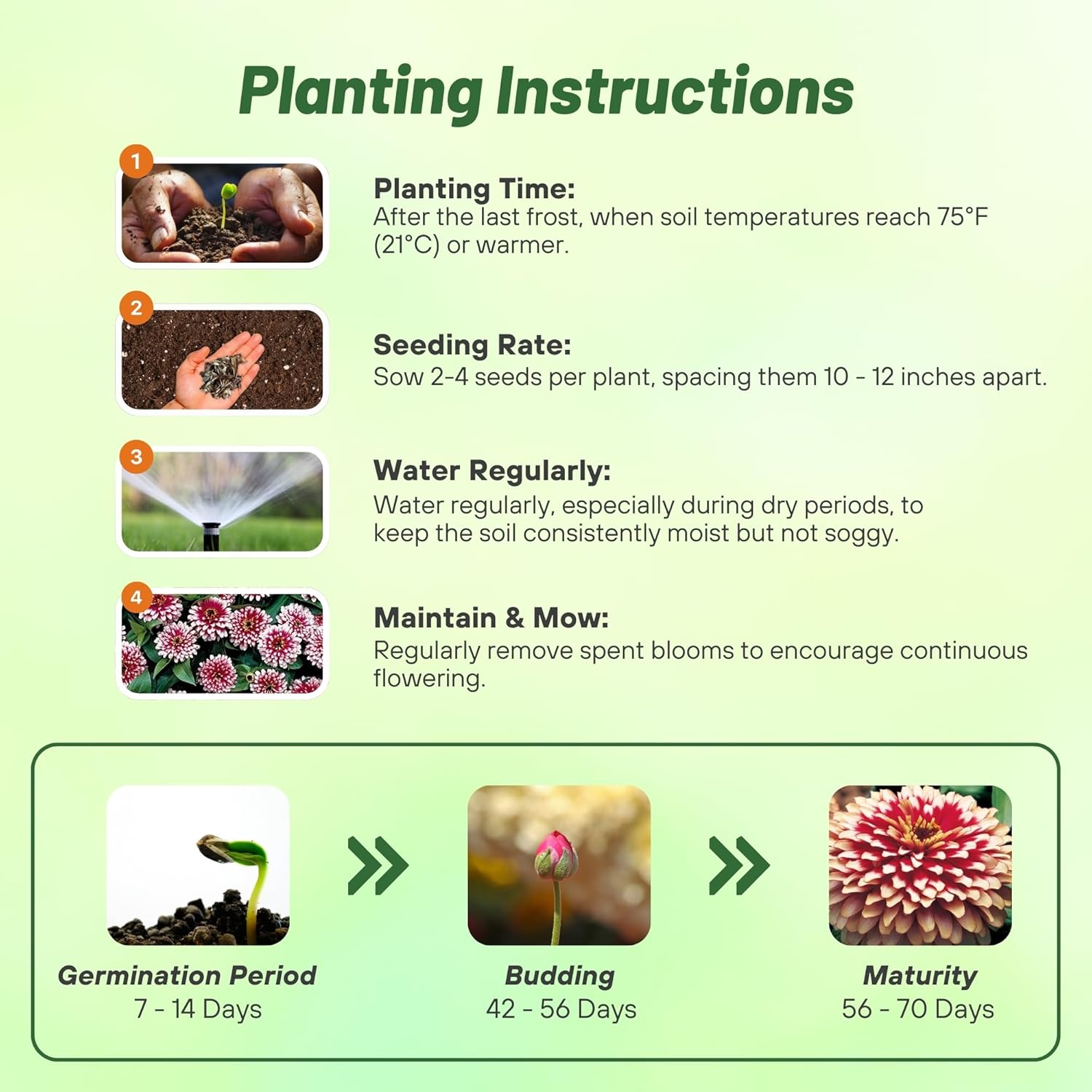



Zinnia Seeds - Cherry Ivory
About...
(Zinnia Elegans Swizzle Cherry Ivory) - Shake up your flower garden with these striking bicolors. Eye-catching, fully double, and red and white bicolor flowers demand attention. Full, bushy plants growing 12 - 14 inches tall and 10 - 12 inches wide are covered with 3 - 4 inch blooms.MORE ZINNIA OPTIONS
Planting Directions
TEMPERATURE
75F
AVERAGE GERM TIME
7 - 14 days
LIGHT REQUIRED
No
DEPTH
Cover seed lightly 1/16 - 1/8th inch
SOWING RATE
2 - 4 seeds per plant
MOISTURE
Keep soil slightly moist but not wet until germination
PLANT SPACING
10 - 12 inches

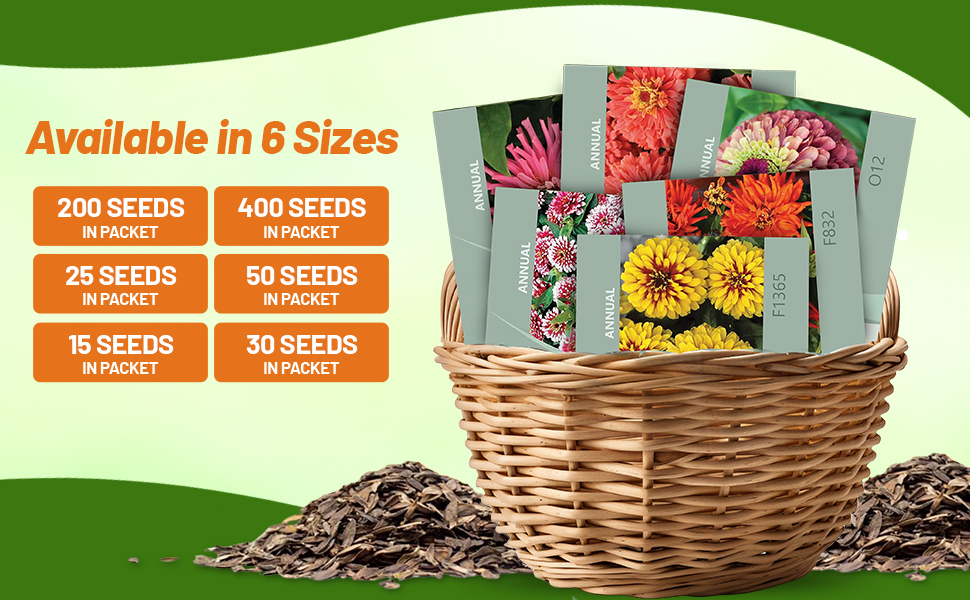

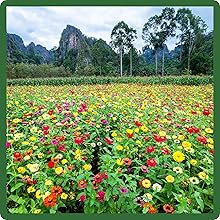
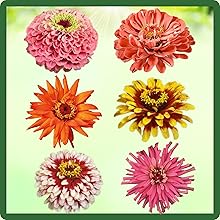




Zinnia (Zinnia Elegans Swizzle Cherry Ivory) - Shake up your flower garden with these striking bicolors. Eye-catching, fully double, and red and white bicolor flowers demand attention. Full, bushy plants growing 12 - 14 inches tall and 10 - 12 inches wide are covered with 3 - 4 inch blooms. Zinnias are heat loving plants and can tolerate arid climates as well.
Zinnias are one of the easiest annuals to grow, and attract butterflies to the garden. They make an excellent cut flower as the more you cut, the more flowers you get! They thrive in the sun and heat of summer, only asking for well-drained soil. When cutting the blooms for the vase it is best to trim off all the foliage; unlike the blooms, the foliage does not age well.
Common Questions
How do I condition my cut zinnia flowers?
Bring a bucket of water with you to the garden when you cut your flowers and put them in the water as soon as you cut them. This will allow them to take up water through the freshly cut stem. Cut on an angle to give more surface area for the water to be taken up. Keep them out of the direct sun.
Do I need to stake my zinnias?
Taller varieties may benefit from staking, especially if they are in a windy area.
Why are my zinnias tall and thin with much smaller flowers than expected?
If zinnias are planted too closely, they will produce tall plants and much smaller flowers. Always follow the recommended spacing on the planting instructions.
Can I encourage more blooms on my zinnia plants?
Yes, first you will need to ensure your plants are in a full sun area to get a good bloom season from your plants. You can pinch the main growth of young plants when they are about 12 inches tall to encourage more branching which will increase your number of blooms. Also, deadhead your spent blooms throughout summer to encourage a longer bloom season.
Will flowers attract any pollinators to my garden?
Yes, butterflies and hummingbirds enjoy these flowers.
Will deer eat my flowers?
No, deer tend to avoid these plants.
Can I grow in containers?
Yes, these flowers can do well in a container.
What are some good companion plants for zinnia?
Zinnia plants can be complimented with marigolds, cosmos, nasturtiums, salvia, ageratum. Cleome, dahlia, verbena or sunflowers just to name a few.
Planting Directions
TEMPERATURE
75F
AVERAGE GERM TIME
7 - 21 days
LIGHT REQUIRED
No
DEPTH
Cover seed lightly with peat moss
SOWING RATE
2 - 4 seeds per plant or approximately 9 lbs per acre
MOISTURE
Keep soil slightly moist but not wet until germination
PLANT SPACING
12 inches
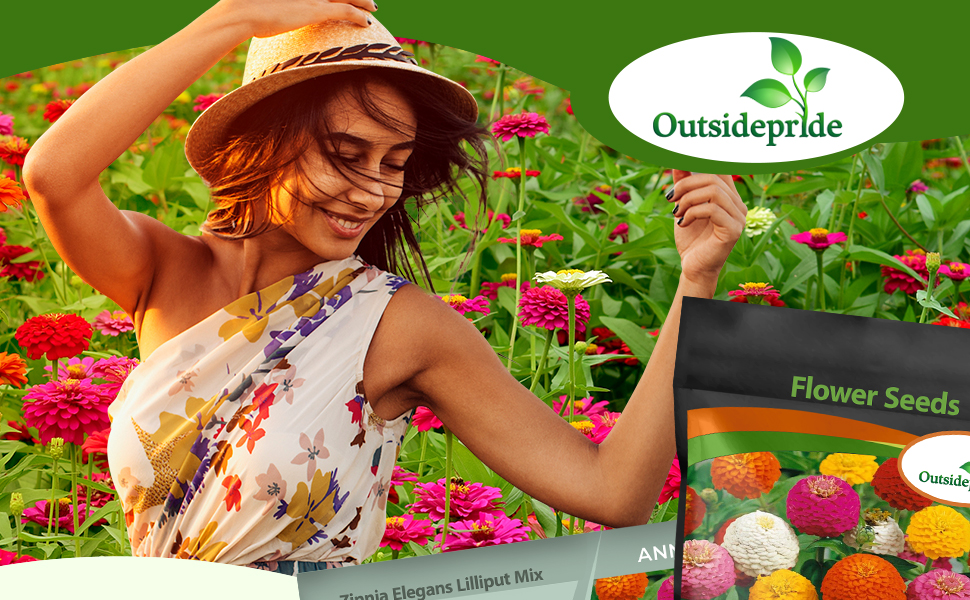

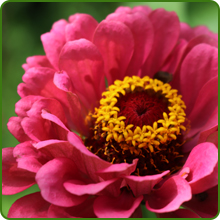






Zinnia (Zinnia Elegans Lilliput Mix) - Perfect for the front yard flower border, grow this semi-dwarf variety from Zinnia seeds. Zinnias are hardy plants that will do well in all types of weather. This Lilliput Zinnia mix has shades of pink, yellow, white and red, and these flowers will blossom 6 - 8 weeks after sowing the flower seeds. This shorter growing variety features a wide range of brilliant colors and double 1 inch round pompon-like blooms. Lilliput Zinnias are the perfect size for container plantings or grow them in the front of the flower border. They prefer full sun and soil that does not hold water. Hummingbirds love them, but thankfully, deer do not bother them!
Common Questions
How do I condition my cut zinnia flowers?
Bring a bucket of water with you to the garden when you cut your flowers and put them in the water as soon as you cut them. This will allow them to take up water through the freshly cut stem. Cut on an angle to give more surface area for the water to be taken up. Keep them out of the direct sun.
Do I need to stake my zinnias?
Taller varieties may benefit from staking, especially if they are in a windy area.
Why are my zinnias tall and thin with much smaller flowers than expected?
If zinnias are planted too closely, they will produce tall plants and much smaller flowers. Always follow the recommended spacing on the planting instructions.
Can I encourage more blooms on my zinnia plants?
Yes, first you will need to ensure your plants are in a full sun area to get a good bloom season from your plants. You can pinch the main growth of young plants when they are about 12 inches tall to encourage more branching which will increase your number of blooms. Also, deadhead your spent blooms throughout summer to encourage a longer bloom season.
Will flowers attract any pollinators to my garden?
Yes, butterflies and hummingbirds enjoy these flowers.
Will deer eat my flowers?
No, deer tend to avoid these plants.
Can I grow in containers?
Yes, these flowers can do well in a container.
What are some good companion plants for zinnia?
Zinnia plants can be complimented with marigolds, cosmos, nasturtiums, salvia, ageratum. Cleome, dahlia, verbena or sunflowers just to name a few.
Planting Directions
TEMPERATURE
75F
AVERAGE GERM TIME
7 - 14 days
LIGHT REQUIRED
No
DEPTH
Cover seed lightly with peat moss
SOWING RATE
2 - 4 seeds per plant
MOISTURE
Keep soil slightly moist but not wet until germination
PLANT SPACING
18 - 20 inches

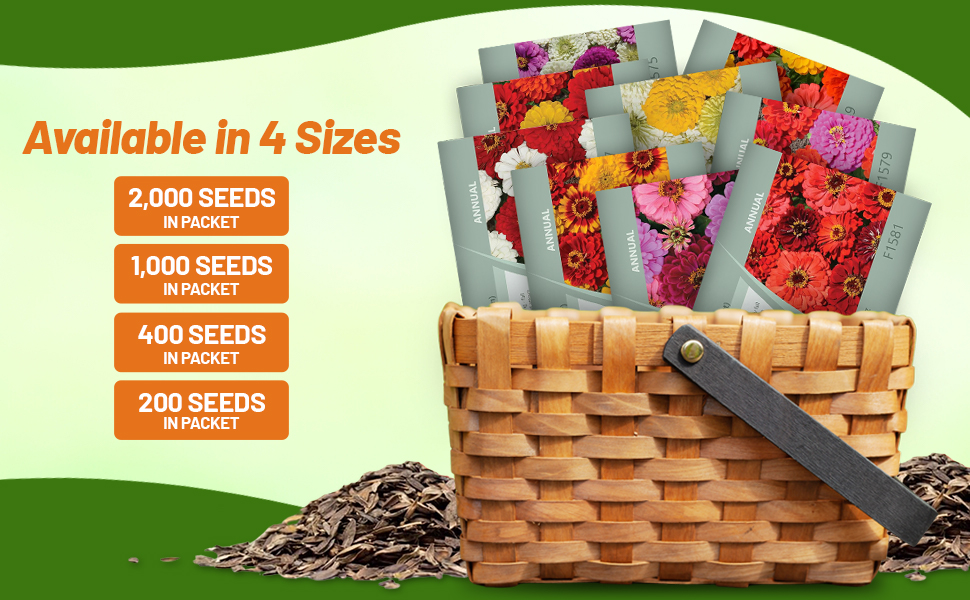



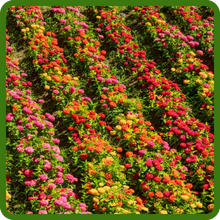
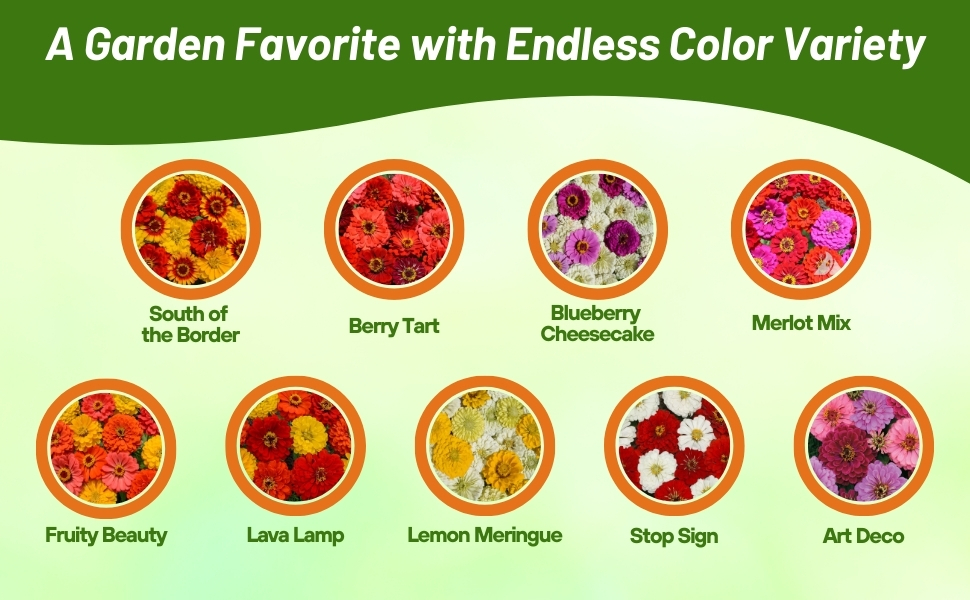
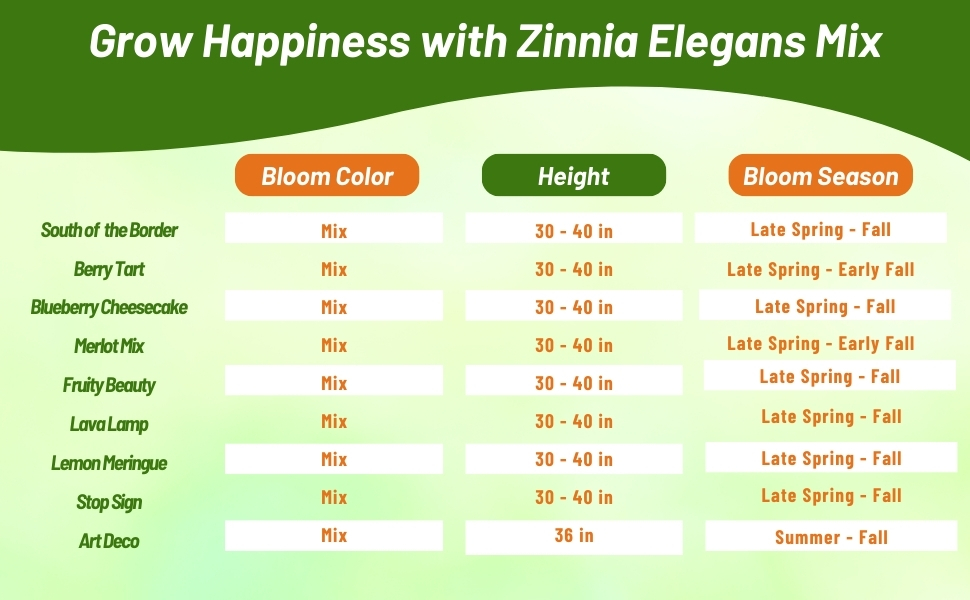

Zinnia (Zinnia Elegans Lemon Meringue) - The Lemon Meringue Zinnia Mix is composed of our ‘Polar Bear’, ‘Canary Bird’, and ‘Envy’ Zinnia varieties, creating a frothy white, lemon yellow and lime green color combination. Zinnia varieties and is recommended for cut flower bouquets as well as beds and borders. These low maintenance zinnias attract butterflies and are heat and drought tolerant. Award winning performance and durability in landscapes and containers, especially in sunny, hot, dry locations. This mixture produces beautiful blooms of semi-double to double flowers on each stem.
Zinnias are one of the easiest annuals to grow, and attract butterflies to the garden. They make an excellent cut flower as the more you cut, the more flowers you get! They thrive in the sun and heat of summer, only asking for well-drained soil. When cutting the blooms for the vase it is best to trim off all the foliage; unlike the blooms, the foliage does not age well.
Common Questions
How do I condition my cut zinnia flowers?
Bring a bucket of water with you to the garden when you cut your flowers and put them in the water as soon as you cut them. This will allow them to take up water through the freshly cut stem. Cut on an angle to give more surface area for the water to be taken up. Keep them out of the direct sun.
Do I need to stake my zinnias?
Taller varieties may benefit from staking, especially if they are in a windy area.
Why are my zinnias tall and thin with much smaller flowers than expected?
If zinnias are planted too closely, they will produce tall plants and much smaller flowers. Always follow the recommended spacing on the planting instructions.
Can I encourage more blooms on my zinnia plants?
Yes, first you will need to ensure your plants are in a full sun area to get a good bloom season from your plants. You can pinch the main growth of young plants when they are about 12 inches tall to encourage more branching which will increase your number of blooms. Also, deadhead your spent blooms throughout summer to encourage a longer bloom season.
Will flowers attract any pollinators to my garden?
Yes, butterflies and hummingbirds enjoy these flowers.
Will deer eat my flowers?
No, deer tend to avoid these plants.
Can I grow in containers?
Yes, these flowers can do well in a container.
What are some good companion plants for zinnia?
Zinnia plants can be complimented with marigolds, cosmos, nasturtiums, salvia, ageratum. Cleome, dahlia, verbena or sunflowers just to name a few.
Planting Directions
TEMPERATURE
75F
AVERAGE GERM TIME
7 - 14 days
LIGHT REQUIRED
No
DEPTH
Cover seed lightly 1/16 - 1/8th inch
SOWING RATE
2 - 4 seeds per plant
MOISTURE
Keep soil slightly moist but not wet until germination
PLANT SPACING
8 - 10 inches



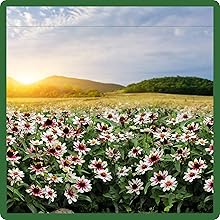



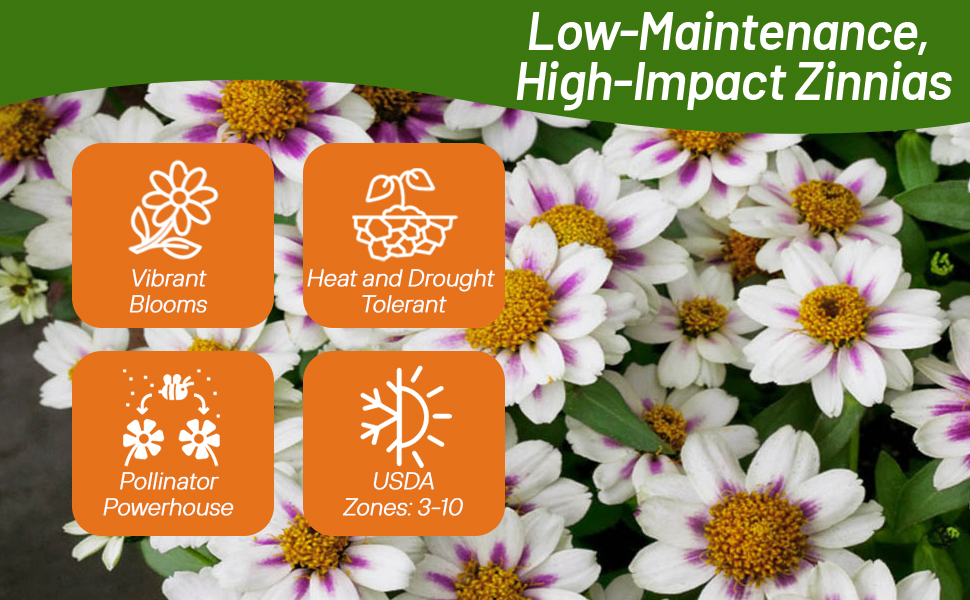
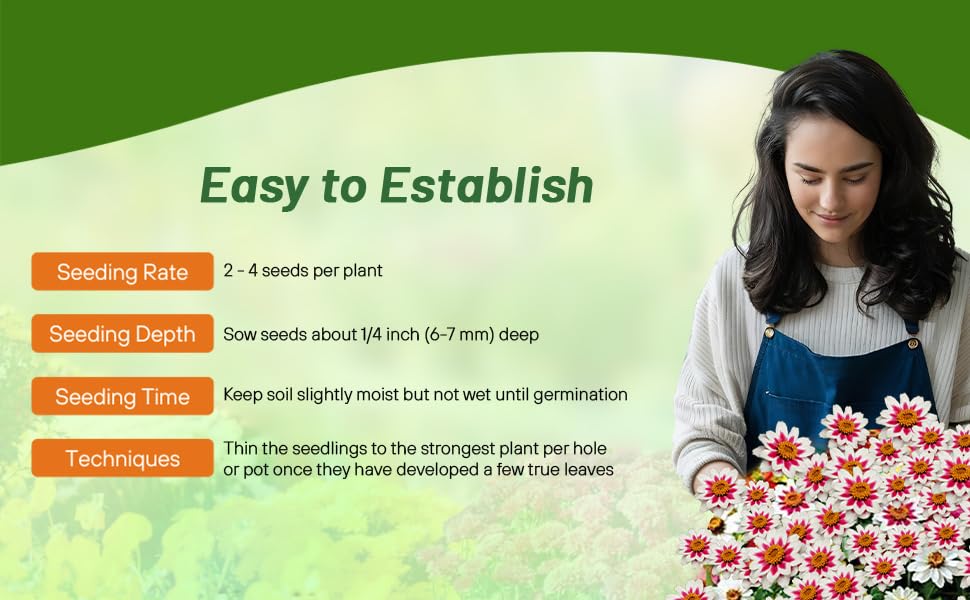
Zinnia (Zinnia Marylandica Zahara Rose Starlight) - These rose starlight plants grow 12 - 14 inches tall and 12 - 18 inches wide. Zinnias are great at attacting bees and butterflies as well as being drought tolerant, heat tolerant, and low maintenance. These white flowers with a rose colored interior add stunning color to your flower garden.
Zinnias are one of the easiest annuals to grow, and attract butterflies to the garden. They make an excellent cut flower as the more you cut, the more flowers you get! They thrive in the sun and heat of summer, only asking for well-drained soil. When cutting the blooms for the vase it is best to trim off all the foliage; unlike the blooms, the foliage does not age well.
2010 AAS Bedding Plant Winner. Stunning white flowers with rose stripes are a new bicolor for zinnias. Superior disease resistance to leaf spot and mildew result in long-lasting plants where other zinnias have failed. Enjoy this easy-growing heat and drought tolerant zinnia in your sunny garden or container. Mature plants reaching 12 to 14 inches tall abound with large colorful 2.5 inch blooms all season long with minimum care. Full sun annual.
Common Questions
How do I condition my cut zinnia flowers?
Bring a bucket of water with you to the garden when you cut your flowers and put them in the water as soon as you cut them. This will allow them to take up water through the freshly cut stem. Cut on an angle to give more surface area for the water to be taken up. Keep them out of the direct sun.
Do I need to stake my zinnias?
Taller varieties may benefit from staking, especially if they are in a windy area.
Why are my zinnias tall and thin with much smaller flowers than expected?
If zinnias are planted too closely, they will produce tall plants and much smaller flowers. Always follow the recommended spacing on the planting instructions.
Can I encourage more blooms on my zinnia plants?
Yes, first you will need to ensure your plants are in a full sun area to get a good bloom season from your plants. You can pinch the main growth of young plants when they are about 12 inches tall to encourage more branching which will increase your number of blooms. Also, deadhead your spent blooms throughout summer to encourage a longer bloom season.
Will flowers attract any pollinators to my garden?
Yes, butterflies and hummingbirds enjoy these flowers.
Will deer eat my flowers?
No, deer tend to avoid these plants.
Can I grow in containers?
Yes, these flowers can do well in a container.
What are some good companion plants for zinnia?
Zinnia plants can be complimented with marigolds, cosmos, nasturtiums, salvia, ageratum. Cleome, dahlia, verbena or sunflowers just to name a few.
Planting Directions
TEMPERATURE
75F
AVERAGE GERM TIME
7 - 14 days
LIGHT REQUIRED
No
DEPTH
Cover seed lightly 1/16 - 1/8th inch
SOWING RATE
2 - 4 seeds per plant
MOISTURE
Keep soil slightly moist but not wet until germination
PLANT SPACING
8 - 10 inches


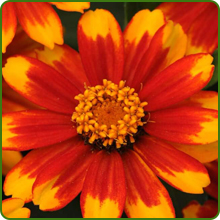
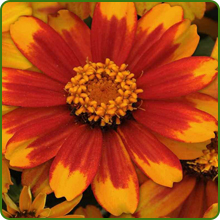





Zinnia (Zinnia Marylandica Zahara Sunburst) - This orage-red zinnia with yellow tips grows 12 - 18 inches tall and 12 - 18 inches wide. Zinnias are great at attacting bees and butterflies as well as being drought tolerant, heat tolerant, and low maintenance. They are also very disease resistant plants making them virtually carefree.
Zinnias are one of the easiest annuals to grow, and attract butterflies to the garden. They make an excellent cut flower as the more you cut, the more flowers you get! They thrive in the sun and heat of summer, only asking for well-drained soil. When cutting the blooms for the vase it is best to trim off all the foliage; unlike the blooms, the foliage does not age well.
Common Questions
How do I condition my cut zinnia flowers?
Bring a bucket of water with you to the garden when you cut your flowers and put them in the water as soon as you cut them. This will allow them to take up water through the freshly cut stem. Cut on an angle to give more surface area for the water to be taken up. Keep them out of the direct sun.
Do I need to stake my zinnias?
Taller varieties may benefit from staking, especially if they are in a windy area.
Why are my zinnias tall and thin with much smaller flowers than expected?
If zinnias are planted too closely, they will produce tall plants and much smaller flowers. Always follow the recommended spacing on the planting instructions.
Can I encourage more blooms on my zinnia plants?
Yes, first you will need to ensure your plants are in a full sun area to get a good bloom season from your plants. You can pinch the main growth of young plants when they are about 12 inches tall to encourage more branching which will increase your number of blooms. Also, deadhead your spent blooms throughout summer to encourage a longer bloom season.
Will flowers attract any pollinators to my garden?
Yes, butterflies and hummingbirds enjoy these flowers.
Will deer eat my flowers?
No, deer tend to avoid these plants.
Can I grow in containers?
Yes, these flowers can do well in a container.
What are some good companion plants for zinnia?
Zinnia plants can be complimented with marigolds, cosmos, nasturtiums, salvia, ageratum. Cleome, dahlia, verbena or sunflowers just to name a few.
Planting Directions
TEMPERATURE
75F
AVERAGE GERM TIME
7 - 14 days
LIGHT REQUIRED
No
DEPTH
Cover seed lightly 1/16 - 1/8th inch
SOWING RATE
2 - 4 seeds per plant
MOISTURE
Keep soil slightly moist but not wet until germination
PLANT SPACING
8 - 10 inches


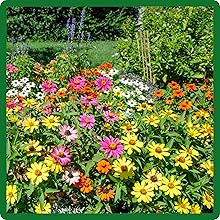


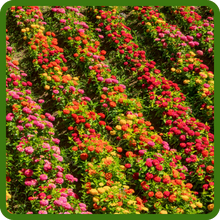
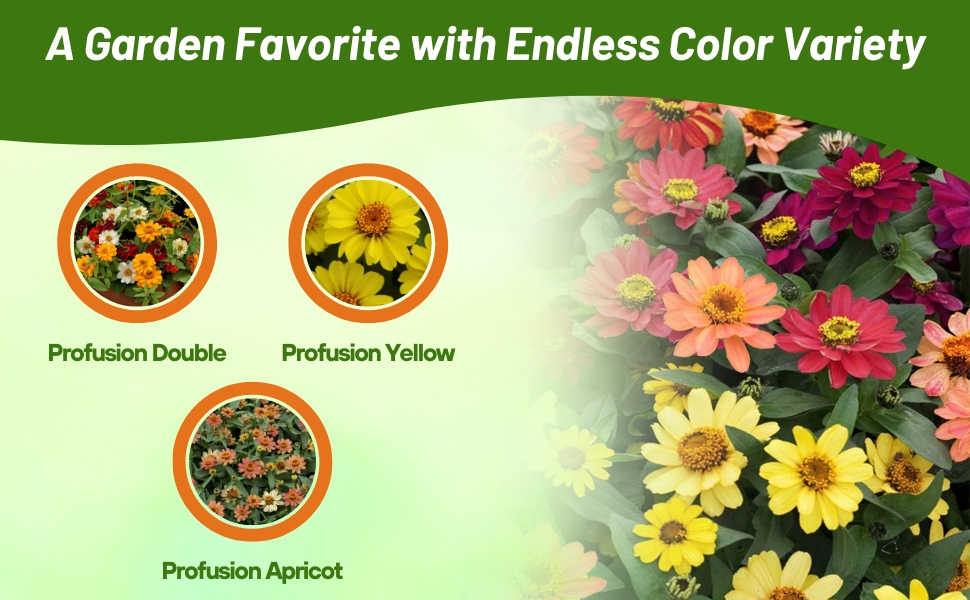

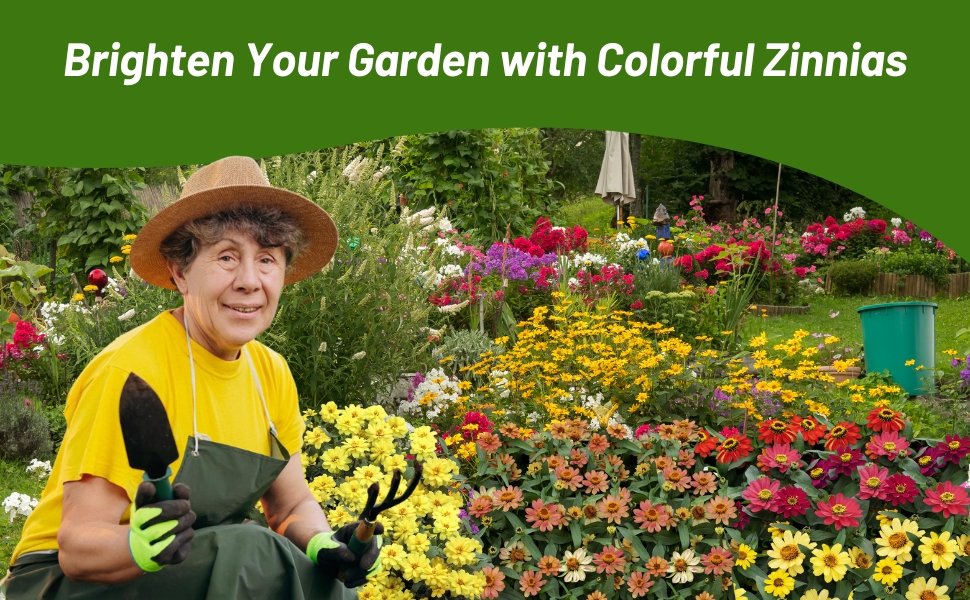
Zinnia (Zinnia Marylandica Profusion Yellow) - The ideal choice for landscape programs where mass plantings of large flowered zinnias are desired. These yellow flowering zinnias grow 12 - 18 inches tall and wide. Tremendous disease resistance for reliable season long performance in the garden or as a container plant.
Zinnias are one of the easiest annuals to grow, and attract butterflies to the garden. They make an excellent cut flower as the more you cut, the more flowers you get! They thrive in the sun and heat of summer, only asking for well-drained soil. When cutting the blooms for the vase it is best to trim off all the foliage; unlike the blooms, the foliage does not age well.
Common Questions
How do I condition my cut zinnia flowers?
Bring a bucket of water with you to the garden when you cut your flowers and put them in the water as soon as you cut them. This will allow them to take up water through the freshly cut stem. Cut on an angle to give more surface area for the water to be taken up. Keep them out of the direct sun.
Do I need to stake my zinnias?
Taller varieties may benefit from staking, especially if they are in a windy area.
Why are my zinnias tall and thin with much smaller flowers than expected?
If zinnias are planted too closely, they will produce tall plants and much smaller flowers. Always follow the recommended spacing on the planting instructions.
Can I encourage more blooms on my zinnia plants?
Yes, first you will need to ensure your plants are in a full sun area to get a good bloom season from your plants. You can pinch the main growth of young plants when they are about 12 inches tall to encourage more branching which will increase your number of blooms. Also, deadhead your spent blooms throughout summer to encourage a longer bloom season.
Will flowers attract any pollinators to my garden?
Yes, butterflies and hummingbirds enjoy these flowers.
Will deer eat my flowers?
No, deer tend to avoid these plants.
Can I grow in containers?
Yes, these flowers can do well in a container.
What are some good companion plants for zinnia?
Zinnia plants can be complimented with marigolds, cosmos, nasturtiums, salvia, ageratum. Cleome, dahlia, verbena or sunflowers just to name a few.
Planting Directions
TEMPERATURE
75F
AVERAGE GERM TIME
7 - 21 days
LIGHT REQUIRED
No
DEPTH
Cover seed lightly with peat moss
SOWING RATE
2 - 4 seeds per plant
MOISTURE
Keep seeds moist until germination
PLANT SPACING
12 inches
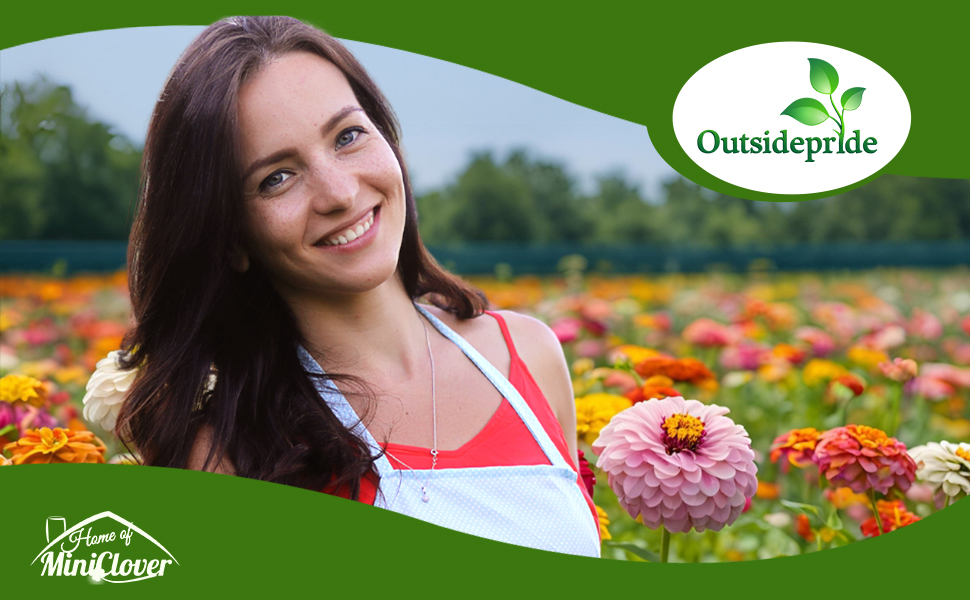



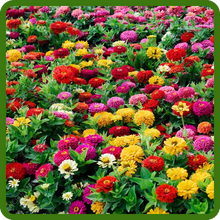


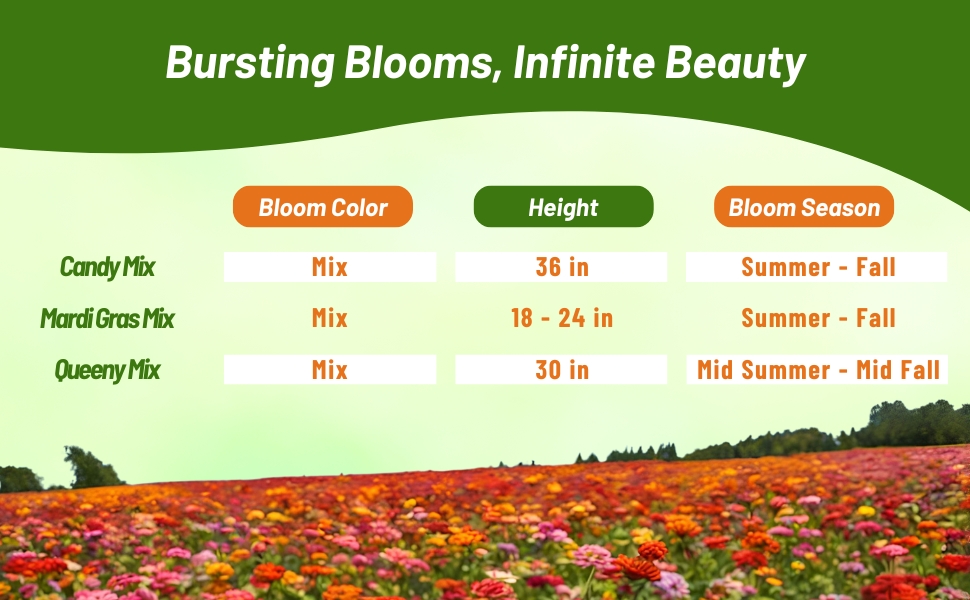
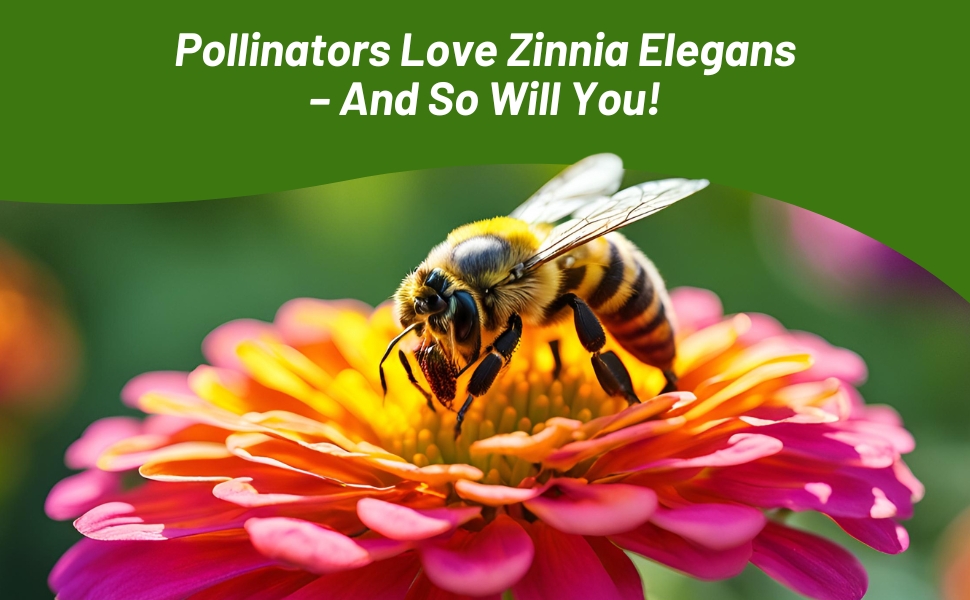
Zinnia (Zinnia Elegans Mardi Gras Mix) - The Mardi Gras Zinnia Mix is composed of our "Canary Bird', "Polar Bear" and "Purple Prince" Zinnia varieties and is recommended for cut flower bouquets as well as beds and borders. A great mix of white, purple, and yellow flowers. Attracts butterflies to your beds and borders.
Common Questions
How do I condition my cut zinnia flowers?
Bring a bucket of water with you to the garden when you cut your flowers and put them in the water as soon as you cut them. This will allow them to take up water through the freshly cut stem. Cut on an angle to give more surface area for the water to be taken up. Keep them out of the direct sun.
Do I need to stake my zinnias?
Taller varieties may benefit from staking, especially if they are in a windy area.
Why are my zinnias tall and thin with much smaller flowers than expected?
If zinnias are planted too closely, they will produce tall plants and much smaller flowers. Always follow the recommended spacing on the planting instructions.
Can I encourage more blooms on my zinnia plants?
Yes, first you will need to ensure your plants are in a full sun area to get a good bloom season from your plants. You can pinch the main growth of young plants when they are about 12 inches tall to encourage more branching which will increase your number of blooms. Also, deadhead your spent blooms throughout summer to encourage a longer bloom season.
Will flowers attract any pollinators to my garden?
Yes, butterflies and hummingbirds enjoy these flowers.
Will deer eat my flowers?
No, deer tend to avoid these plants.
Can I grow in containers?
Yes, these flowers can do well in a container.
What are some good companion plants for zinnia?
Zinnia plants can be complimented with marigolds, cosmos, nasturtiums, salvia, ageratum. Cleome, dahlia, verbena or sunflowers just to name a few.
Planting Directions
TEMPERATURE
75F
AVERAGE GERM TIME
7 - 14 days
LIGHT REQUIRED
No
DEPTH
Cover seed lightly 1/16 - 1/8th inch
SOWING RATE
2 - 4 seeds per plant
MOISTURE
Keep soil slightly moist but not wet until germination
PLANT SPACING
10 inches





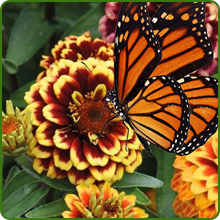

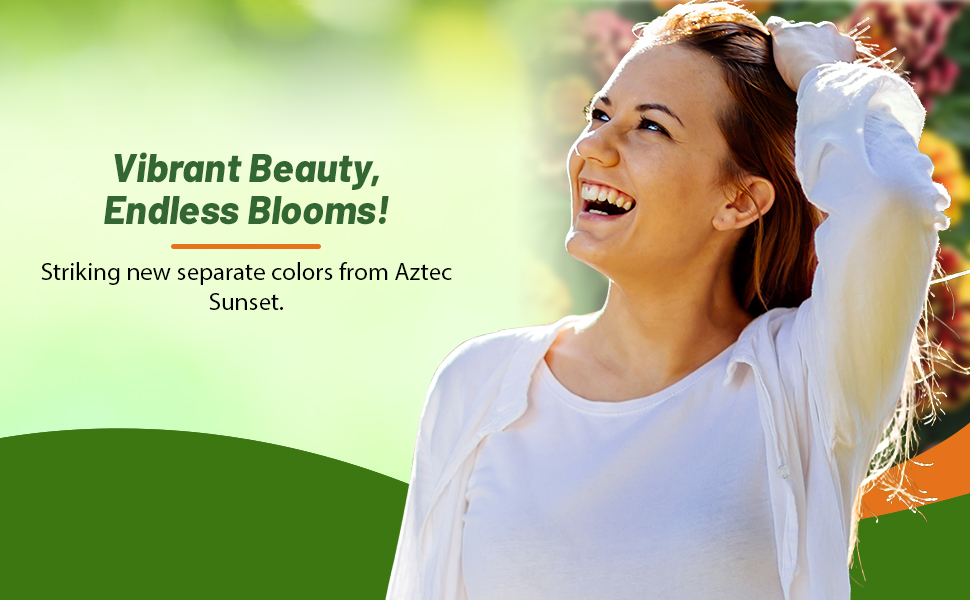

Zinnia (Zinnia haageana Aztec Sunset) - An ultra compact plant only growing to approximately 6 inches tall and spreading 10 inches wide. Zinnia Aztec Sunset is carpeted in double 2 inch bicolor flowers in cream, gold, rust, and red make a rare treat. Blooms from early summer until frost. Aztec Sunset includes unique shades not found in other zinnias. Plants are exceptionally heavy flowering, and show a strong resistance to powdery mildew. Due to its ability to tolerate heat, this zinnia has won the Dallas Arboretum's "Flameproof" award for its ability to thrive in Texas heat.
Common Questions
How do I condition my cut zinnia flowers?
Bring a bucket of water with you to the garden when you cut your flowers and put them in the water as soon as you cut them. This will allow them to take up water through the freshly cut stem. Cut on an angle to give more surface area for the water to be taken up. Keep them out of the direct sun.
Do I need to stake my zinnias?
Taller varieties may benefit from staking, especially if they are in a windy area.
Why are my zinnias tall and thin with much smaller flowers than expected?
If zinnias are planted too closely, they will produce tall plants and much smaller flowers. Always follow the recommended spacing on the planting instructions.
Can I encourage more blooms on my zinnia plants?
Yes, first you will need to ensure your plants are in a full sun area to get a good bloom season from your plants. You can pinch the main growth of young plants when they are about 12 inches tall to encourage more branching which will increase your number of blooms. Also, deadhead your spent blooms throughout summer to encourage a longer bloom season.
Will flowers attract any pollinators to my garden?
Yes, butterflies and hummingbirds enjoy these flowers.
Will deer eat my flowers?
No, deer tend to avoid these plants.
Can I grow in containers?
Yes, these flowers can do well in a container.
What are some good companion plants for zinnia?
Zinnia plants can be complimented with marigolds, cosmos, nasturtiums, salvia, ageratum. Cleome, dahlia, verbena or sunflowers just to name a few.
































